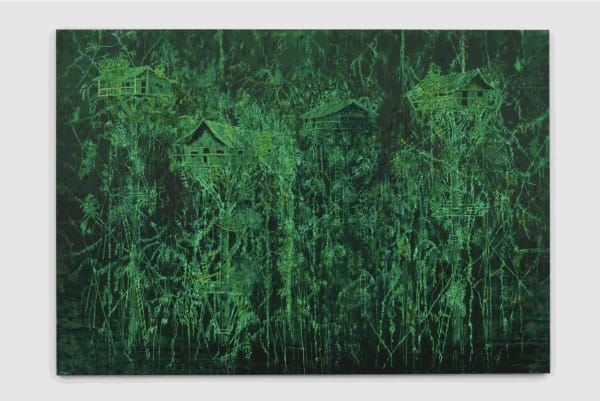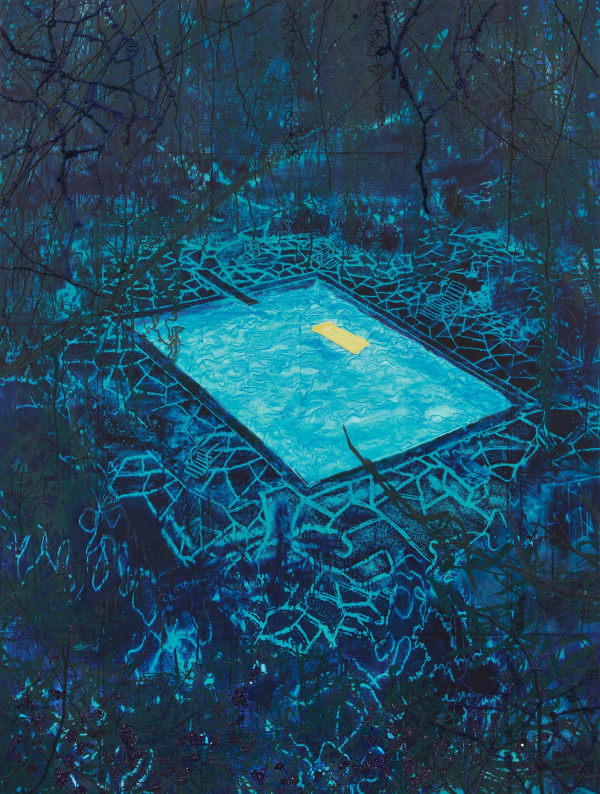Michael Raedecker: now
GRIMM is pleased to present now, an exhibition of new paintings by London-based artist Michael Raedecker opening at its New York gallery on March 4, 2022.
now
The concept now is like a dog chasing its own tail. As soon as now arrives—becomes thought, or imagined, or uttered, or pictured, or written, or said—its meaning switches to recently (and recently lacks the same sex appeal). In other words, now is elusive; difficult to catch but we run after it all the same.
capture
From a distance, the flat and rectangular objects that Raedecker has produced have the appearance of the things we once called paintings. In the studio he has engineered a mechanism of capture, which manufactures products that contradict our efforts to form certainty. Instead, as we approach the objects, getting closer to the surface, it dawns that our impressions stem from fantasy, evoking a distinction between imagination and reality. In short, the viewer has been assigned an active task through which their interaction with the image can be felt and perception becomes tangible and within our grasp. Like a focussing lens, looking at Raedecker’s evocative concoctions veers between two realities: psychical and material.
pleasure
The closer we get to the traps, which are disguised as paintings, the more the veil of illusion falls away. Images become paint, paint becomes thread and thread becomes simply itself. The proximity of the canvas surface shatters the viewers’ inventions. No-one is closer to the surface than Raedecker who spends hours going in and out of the surface, from the front to the back “and back again”.
mechanical reproduction
Did you know, these flat objects on the walls are facsimiles of pre-existing images made by the artist? In the lengthy process Raedecker makes smaller versions, sketches (he calls them demos) which are digitally copied, painted and manipulated and enlarged and transferred to these surfaces. Like the endless reproductions that constitute our so-called (authentic) reality, we are looking at sophisticated copies, saturated in monochrome colour. Raedecker goes even further and copies and repeats images within an exhibition: the pool and the pool, and the tents and the tents, and the treehouses and the treehouses. Are we really expected to project alternatives onto the second and third instance of the copy? Isn’t the artist highlighting the eternal recurrence of the same set of narratives we repeat culturally and repeat to ourselves?
can’t see the wood for the trees
Up close the viewing experience is all material (applied through an overloaded clash of handmade versus mechanical processes). Back up and, as the colliding elements coalesce, the picture emerges. Here, Raedecker’s objects provide some sort of lesson in how to look at a painting. The how and not the what—as if the pictorial illusion (the wood/forest above) provides only a MacGuffin.
holes
The making of holes represents the core elusive metaphor of the Raedecker enterprise. If he is known for one thing it is threading and threading begins with making a hole. With a needle, as soon as the hole is formed, it is filled. Pictorially the hole is a screen onto which the protagonist (or viewer) has the space to imagine, and even fulfill, desire. We might otherwise call these daydreams: scenes, episodes, romances or fictions formed by the viewer. Is it just me, my wishes fattened (or thinned) on a diet of mainstream TV and movies, or do these holes evoke dark foreboding for us all? Misdemeanours? Crimes? Violence? Murder? Death? Why might we be seduced by such places? Why might these frequently exotic images, with their unhomely connotations, make us feel cosy? And, by way of an answer: could these holes paradoxically provide the viewer with a glimmer of completeness? After all, isn’t feeling whole, cosy in a nutshell.
-Stuart Cumberland, 2022
Michael Raedecker (b. 1963 in Amsterdam, NL) currently lives and works in London (UK). He received his BA in Fashion Design from the Gerrit Rietveld Academie, Amsterdam (NL), and continued his studies at the Rijksakademie van Beeldende Kunsten, Amsterdam (NL) as well as Goldsmiths College, London (UK). In 2000, Raedecker was shortlisted for the Turner Prize. His work can be found in the collections of the Art Institute of Chicago, IL (US); Akzo Nobel Art Collection, Amsterdam (NL); British Art Council, London (UK); Guggenheim Museum, New York, NY (US); Kunstmuseum, The Hague (NL); Astrup Fearnley Museum, Oslo (NO); Tate, London (UK); MAXXI National Museum of XXI Century Arts, Rome (IT); Van Abbemuseum, Eindhoven (NL), Museum Voorlinden, Wassenaar (NL), amongst others, as well as in many private collections.
















